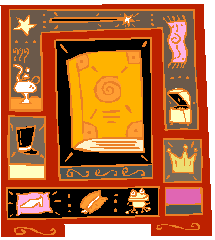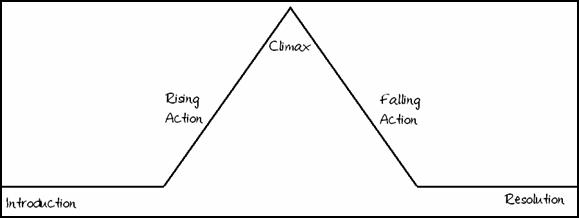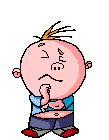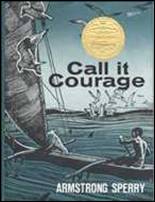COMPREHENSION, WRITING A NARRATIVE

Unit Overview: You will be
answering questions using Call It
Courage, and you will be writing your own narrative.
Answer questions from Chapters 1 and 2 in Call It Courage.
![]() Now answer questions 1-5
Now answer questions 1-5
Continue to read Call it Courage. There will be
questions in upcoming units.
Writing a Narrative

Narrative writing is writing that tells a
story. Narrative writing is more than
just a list of events. In fact, it can
get very boring to read that this happened and then that happened and then this
happened. Instead, a narrative should
include:
·
a plot (the
events that happen).
·
a problem that
needs to be solved.
·
a setting (where
and when the events take place).
·
characters (who
do things for a reason).
·
a point or
purpose for the story.
All narratives are told from
a point of view. Narrative stories can
be told from inside the story or outside the story. If the story is told from inside, the
character telling the story is part of the action of the narrative. This is called first-person point of view.
In first-person point of view, one character tells the story using
pronouns like “I” and “we”. The
character telling the story is usually the main character. The reader often gets a limited view of the
story’s events when first-person point of view is used. Only one character’s thoughts and experiences
are shared.
In order to know the thoughts
and experiences of more characters, an author can write in third-person. In third-person point of view, the narrator
is telling the story instead of a character telling it. This point of view gives you information
about all of the characters rather than just one character.
The plot of a
narrative is what happens in the story.
Again, this isn’t just a simple list of events. Each event needs to have something to do with
the point of the story. The plot
includes the actions of the characters, their thoughts, their feelings, and
what they say. The plot follows a
predictable pattern and includes five parts.
The picture and chart below show the parts of a narrative and explain
what each part is.

|
Parts
of the Narrative Plot |
|
|
Introduction |
The introduction is the beginning of the narrative. It contains the hook that keeps the
reader’s attention. This part of the
narrative introduces the reader to the characters and gives the background
knowledge that is needed for the rest of the story to make sense. |
|
Rising Action |
The rising action is the part of the narrative when the
character begins to encounter a problem.
There are complications that add drama to the problem. This is where the level of excitement
builds. |
|
Climax |
The climax is the narrative’s most dramatic moment. The character comes face-to-face with the
problem. It is usually the turning
point in the story. |
|
Falling Action |
The falling action comes after the climax. It is when the drama slows down and life
gets back to normal. |
|
Resolution |
The resolution is the end of the story. This is when the problem has been solved
and the loose ends are tied up. |
Add details to
your narrative to make it more interesting for the reader. Look at the chart
below to assist you.
|
Narrative
Writing: Adding Details |
|||
|
What did
you see? |
What did
you hear? |
What did
you think? |
What did
you say to others? |
|
|
|
|
|
Personal Narrative


Think of a time when you did something you really
shouldn't have. Write a narrative telling about that time. Give as many details
as you can think of to really give a good visual of the situation.
To write a high-quality
narrative, remember these things:
·
Begin your
writing with a hook. Use the chart above
to choose the best type of hook for your narrative.
·
As you write,
include details about what you saw, what you heard, what you thought, and what
you said to others.
·
Remember to
explain the problem and how it is solved.
·
Your narrative
should also describe details about the setting.
·
Tell the story
fully, giving information about characters.
·
Include dialogue
(conversation between the characters).
·
Organize the
story so that it makes sense.
Once you write your
narrative, go back and proofread your story.
Be sure you used complete sentences.
Check your spelling, capitalization, and punctuation.
First
steps for writing a narrative essay:
![]() Identify the experience
that you want to write about.
Identify the experience
that you want to write about.
![]() Think about why the
experience is significant.
Think about why the
experience is significant.
![]() Spend a good deal of
time drafting your recollections about the details of the experience.
Spend a good deal of
time drafting your recollections about the details of the experience.
![]() Create an outline of
the basic parts of your narrative.
Create an outline of
the basic parts of your narrative.
Writing
about the experience:
![]() Using your outline,
describe each part of your narrative.
Using your outline,
describe each part of your narrative.
![]() Rather than telling
your readers what happened, use vivid details and descriptions to actually
recreate the experience for your readers.
Rather than telling
your readers what happened, use vivid details and descriptions to actually
recreate the experience for your readers.
![]() Think like your
readers. Try to remember that the information you present is the only
information your readers have about the experiences.
Think like your
readers. Try to remember that the information you present is the only
information your readers have about the experiences.
![]() Always keep in mind
that all of the small and seemingly unimportant details known to you are not
necessarily known to your readers.
Always keep in mind
that all of the small and seemingly unimportant details known to you are not
necessarily known to your readers.
Using
a Rubric to Evaluate Your Narrative
 A rubric is a tool that is used to score
writing. The rubric lists the parts of
your narrative that will be graded. You
earn points depending on how well you do each part. The rubric below will be used to grade your
narrative.
A rubric is a tool that is used to score
writing. The rubric lists the parts of
your narrative that will be graded. You
earn points depending on how well you do each part. The rubric below will be used to grade your
narrative.
|
Narrative
Writing Rubric |
||||
|
CATEGORY |
4 |
3 |
2 |
1 |
|
Introduction
|
First
paragraph has a "grabber" or catchy beginning. |
First
paragraph has a weak "grabber". |
A
catchy beginning was attempted but was confusing rather than catchy. |
No
attempt was made to catch the reader's attention in the first paragraph. |
|
Organization
|
The
story is very well organized. One idea or scene follows another in a logical
sequence with clear transitions. |
The
story is pretty well organized. One idea or scene may seem out of place.
Clear transitions are used. |
The
story is a little hard to follow. The transitions are sometimes not clear. |
Ideas
and scenes seem to be randomly arranged. |
|
Problem/ Conflict
|
It
is very easy for the reader to understand the problem the main characters
face and why it is a problem. |
It
is fairly easy for the reader to understand the problem the main characters
face and why it is a problem. |
It
is fairly easy for the reader to understand the problem the main characters
face but it is not clear why it is a problem. |
It
is not clear what problem the main characters face. |
|
Solution/ Resolution
|
The
solution to the character's problem is easy to understand, and is logical.
There are no loose ends. |
The
solution to the character's problem is easy to understand, and is somewhat
logical. |
The
solution to the character's problem is a little hard to understand. |
No
solution is attempted or it is impossible to understand. |
|
Creativity
|
The
story contains many creative details and/or descriptions that contribute to
the reader's enjoyment. The
author has really used imagination. |
The
story contains a few creative details and/or descriptions that contribute to
the reader's enjoyment. The
author has used imagination. |
The
story contains a few creative details and/or descriptions, but they distract
from the story. The author has tried to use imagination. |
There
is little evidence of creativity in the story. The author does not seem to
have used much imagination. |
|
Dialogue
|
There
is an appropriate amount of dialogue to bring the characters to life and it
is always clear which character is speaking. |
There
is too much dialogue in this story, but it is always clear which character is
speaking. |
There
is not quite enough dialogue in this story, but it is always clear which
character is speaking. |
It
is not clear which character is speaking. |
|
Spelling
and Punctuation |
There
are no spelling or punctuation errors in the final draft. Character
and place names that the author invented are spelled consistently throughout.
|
There
are fewer than 3 spelling or punctuation errors in the final draft. |
There
are 4 or 5 spelling and punctuation errors in the final draft. |
The
final draft has more than 5 spelling and punctuation errors. |
![]() Now answer questions 6 - 11
Now answer questions 6 - 11
